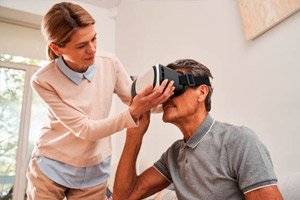
All iLive content is medically reviewed or fact checked to ensure as much factual accuracy as possible.
We have strict sourcing guidelines and only link to reputable media sites, academic research institutions and, whenever possible, medically peer reviewed studies. Note that the numbers in parentheses ([1], [2], etc.) are clickable links to these studies.
If you feel that any of our content is inaccurate, out-of-date, or otherwise questionable, please select it and press Ctrl + Enter.
Virtual reality helps reduce vocal hallucinations in schizophrenia patients
Last reviewed: 27.07.2025
 ">
">The VIRTU group at the Copenhagen University Hospital Research Centre reports that an immersive virtual reality therapy called Challenge-VRT produced statistically significant short-term reductions in the severity of auditory verbal hallucinations in Danish adults with schizophrenia spectrum disorders.
Auditory verbal hallucinations are among the most common and distressing manifestations of schizophrenia, affecting approximately 75% of patients and remaining resistant to medication in about a third of them. About 13% of patients experience worsening hallucinations during the first decade of illness.
Current cognitive-behavioural and relational psychotherapies demonstrate modest effects, leaving a clear need for innovative treatment methods.
In the study, “Virtual reality-based immersive therapy for persistent auditory verbal hallucinations in patients with schizophrenia spectrum disorders in Denmark: the Challenge randomized clinical trial with blinded assessors,” published in The Lancet Psychiatry, researchers assessed the efficacy and safety of Challenge-VRT compared to extended standard treatment for persistent auditory hallucinations.
The study included 270 adults (mean age 32.83 years; 61% women) recruited from outpatient psychiatric services in the Capital Region of Denmark, the Northern Region of Denmark and the Southern Region of Denmark.
Participants were randomized 1:1 to receive seven weekly sessions of immersive Challenge-VRT plus two maintenance sessions or standard treatment at the same frequency; outcome assessors remained blinded.
Therapists used virtual reality headsets to conduct real-time immersive dialogue between participants and avatars representing their dominant “voices.” The intervention, co-designed with people experiencing hallucinations, focused on regaining control over the voices, increasing self-esteem, and supporting recovery.
The primary endpoint was the Psychotic Symptom Rating Scale – Auditory Hallucinations (PSYRATS-AH) total score at 12 weeks.
Participants receiving Challenge-VRT demonstrated a 12.9% reduction in overall hallucination severity compared to their own baseline scores. Voice frequency also decreased by 14.4% and remained significantly lower after 24 weeks. No significant differences were found in measures of voice-induced distress, perceived voice intensity, assertive response skills, or social function.
The intervention was generally well tolerated. About 37% of Challenge-VRT participants reported a temporary increase in hallucination symptoms after initial dialogues with avatars. Six serious adverse events potentially related to the treatment occurred: five hospitalizations due to symptom exacerbation and one case of self-harm; no deaths or violence were reported.
The study authors conclude that immersive dialogues with avatars in virtual reality represent a feasible and acceptable option for patients with schizophrenia who retain voices despite medication, and point to the potential for wider clinical use as software and supervision models evolve.
